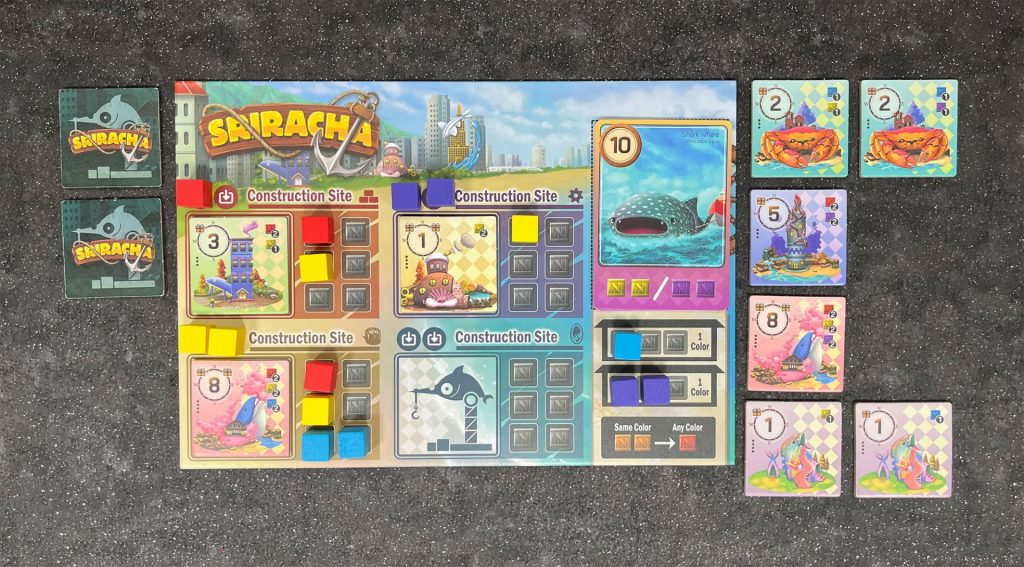Sriracha Overview
Sriracha is a fun and exciting set collection and resource gathering game about managing a busy seaport in the coastal Thailand city of Si Racha, well known for being the birthplace of everyone’s favorite Asian hot sauce. In Sriracha players will use numbered cards to bid for first selection of incoming ships, earmarking their cargos for use in constructing various buildings. After a number of rounds, the player with the most points from individual buildings, and sets of identical buildings, will be the winner. Let’s take a look at a turn in Sriracha to give you a better understanding of how the game plays.

A dash of Sriracha
Before the game begins, each player receives a player board. Then, at the beginning of each round, players are dealt a hand of X Ship cards from the sequentially numbered deck (ranging from 1-25). These cards serve a dual purpose, acting as bids when in your hand, and as ships when laid on the board. Based on player count, deal out the Ship cards in two rows next to the Port Board. Shuffle the Project tiles and place one onto each Ship card.
Players will simultaneously select a card from their hand, and place it face down on the table. This card acts as your bid, allowing you to be the first player to select an incoming ship card. You can always select either of the leftmost ship cards for free, or pay a single resource of any type to skip a ship and pick up one further out to sea.
But let’s take a minute to understand what you’re doing here. Each ship card has a number in the top left corner, a project tile that you’ll need to build, and a set of resources (located at the bottom of the card). When picking a Ship card you not only get the Project tile and the resources (more on these in a moment), but you’re also collecting the Ship card for use in the following round. The Ship card used to bid is discarded and will be reshuffled for use in the next round.

When you collect a Project tile from the Ship card, you place it onto your player board in one of 4 building sites. If you have no open building sites the tile is placed face down to the right and will be worth negative points at the end of the game based on how many resources needed to construct the building. Each Project tile also earns the player 1 or 2 “gifts” (you call it a bribe, we call it a gift), which is paid out upon completion of the building. The color of the gift is dictated by which building site a player chooses.
After placing the Project tile, collect the resources shown at the bottom of the Ship card. Resources can be immediately placed onto a building under construction, or into your warehouse. But be careful, your warehouse has only 6 spaces available, and only 2 different colors of resources can be stored at any given time. Finally, collect the Ship card and place it face down at the top right of your player board. At the beginning of each round (except for the first) players will collect these Ship cards and use them as their bid cards for that round.
As buildings are completed, they’re placed face up to the side. Players earn the number and color of “gifts” associated with that building, and can immediately place those resources onto other buildings, or their warehouse. Players will additionally earn a set bonus for having 3 or 4 of the same building at the end of the game. The dots located at the left side of each Project tile indicate the number of tiles of that type in the stack. All Project tiles will be used in a game.

Full of flavor, with a hint of spice
When I came across a review of Sriracha by another channel I knew it was right in my sweet spot. A relatively short game (the 30-45 minute time on the box is dead on), with delightful brightly colored illustrations and a group of mechanisms that I adore (set collection, clever card play, and resource management). Plus, how often do you get to receive a package from Thailand?!
And friends, let me tell you that I’m glad I did. Sriracha is a great family game which still offers some spice to experienced players. There are two main puzzles to challenge players. The first is in the card play: because you’re building your hand for the next round you have to balance your desire to get high value cards in order to win bids, but you also have to make sure you’re getting the resources you need to complete buildings, and to try and match the buildings you’ve already completed. It’s quite common to bid low in hopes of going later simply because the leftmost ships don’t have the resources you need. It’s also important to keep a spare resource or two so that you’ve got the flexibility to skip a Ship card if need be. Make sure to pay attention to upcoming Project tiles so that you can pick up duplicates in hopes of those sweet set bonuses.
If Sriracha has a weakness it’s in the random distribution of Ship cards and Project tiles. There are only 4 colors of resources in the game, but if you continually get yellows when you need purples, it’s hard to overcome that. Thankfully players can exchange 2 of one resource for 1 of another. And while that’s hardly efficient, if it allows you to complete a building and open up a construction site, then that is a resource well spent. And that’s the other puzzle players need to manage: construction sites; you’ve only got 4 available to you. Since you must pick a new Project tile on every turn you’ll quickly run out of space if you’re not completing them. At the end of the game, any Project tile which can’t be placed, along with any incomplete Project tile, will earn you negative points equal to the number of missing resources for that building.

It’s worth pointing out that while Sriracha doesn’t offer direct player interaction (you can’t steal resources, destroy buildings, or interfere with another player directly), you certainly can affect them indirectly. Because everything but your hand of cards is public information you can easily see what Project tiles another player might be looking for, or the types of resources they need. And that can give you just the intel you need to achieve victory.
Playing Sriracha well is satisfying, knowing that you threaded the needle and came out ahead. And like its saucy namesake, Sriracha goes well with just about anything: a lazy afternoon with the kids, a group game night, or even a 2 player date night. Now if only we can figure out how to get this game to the United States more easily!











Add Comment